Why do eggplant leaves turn yellow and what to do if this happens
It is known that eggplants are more sensitive and capricious than tomatoes and peppers. For this reason, summer residents often have to face the fact that the culture does not develop, turns yellow and withers. This unpleasant phenomenon can be associated with both inaccuracies in care and infectious diseases.
Why eggplant leaves turn yellow, in what cases and how they can be cured - read the article.
The content of the article
Possible causes of yellowing of eggplant leaves
When a discoloration of the sheet plate is detected, identify the cause of what is happening as soon as possible. This will stop the spread of the disease and save part of the crop.
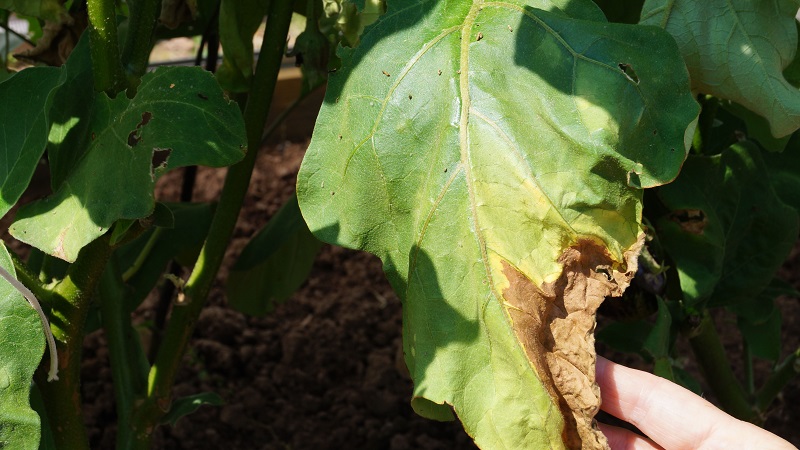
Diseases
When eggplant is damaged by pathogens and fungi yellow or brownish spots appear on the leaves. The most common diseases are:
- Cercosporosis - Due to toxins released by pathogenic fungi, the leaves turn yellow, starting from the edges.
- Verticillosis - under the influence of the fungus, the yellowness spreads along the veins of the leaves, the lower plates twist, and the stem turns brown on the cut.
- Mosaic - yellow-green acute-angled spots appear on the leaves, which increase over time. Fruits on the affected crop grow ugly.
- Fusarium - a fungal disease in which the stem of the plant turns brown, and the leaves turn yellow and dry. If you remove the eggplant from the soil, you will notice that its roots are covered with a pinkish coating.
- Yellowed plates with black dots - most likely, the sprouts were damaged by a spider mite that feeds on leaf juice.
Lack of macro- and microelements
Experienced agronomists know that the land of central Russia contains trace elements that are difficult for plants to assimilate. To provide crops with nutritious food, you need to feed them.
What kind of substance eggplants need is clear from their appearance:
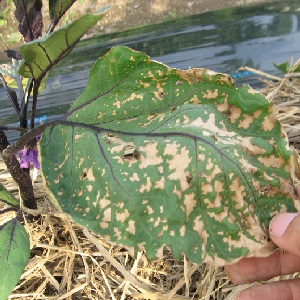 Potassium... The edges of the leaves turn yellow, and the plate itself takes the shape of a boat. The situation can be corrected with the help of potassium humate, potassium sulfate or grass ash.
Potassium... The edges of the leaves turn yellow, and the plate itself takes the shape of a boat. The situation can be corrected with the help of potassium humate, potassium sulfate or grass ash.- Phosphorus... The leaves change color and begin to rush upward.
- Zinc... First of all, the lower leaf plates turn yellow, and then the upper ones.
- Calcium... It feels like the tips of the leaves are burnt.
- Boron... The leaf plates turn yellow and curl.
- Sulfur... The lack of a trace element manifests itself in the form of yellowing of the green mass.
Fertilizers are used in accordance with the instructions... Excessive feeding leads to wilting and death of plants.
Bad soil
To get a good harvest, you need to be responsible for the choice of soil.
Special requirements are imposed on the soil for eggplant:
- Air permeability... So that the root system does not suffer from oxygen deficiency, the soil must be loose and light. This soil will not compact too much after watering.
- Moisture capacity... The earth must quickly absorb moisture and prevent it from evaporating too quickly. Peat practically does not absorb water, so you cannot plant eggplants in it.
- Fertility... The soil must contain organic substances, as well as macro- and microelements in a form accessible for assimilation.
- Acidity... The optimal pH value is from 6.5 to 7 units.
- Purity... The soil should be free of weed seeds, insect larvae and heavy metals.
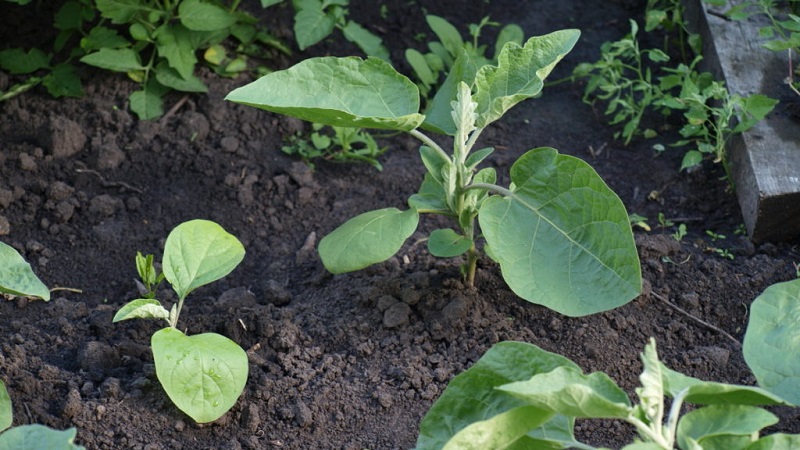
Sunburn
If the plants are too close to the phytolamp or stand in direct sunlight, burns may appear on their leaves. Optimal daylight hours for eggplant - 12 hours. In this case, direct UV radiation causes them irreparable harm.
Attention! Plants are watered only at the root, otherwise the drops on their leaves will enhance the effect of sunlight.
Adaptation period
Seedlings planted in open ground take a long time... For this reason, some leaves may turn yellow. Wait for the young plants to take root, while not ceasing to observe and care for them.
It can be useful:
Instructions for growing eggplant from A to Z
Why do the lower leaves turn yellow
The lower leaf plates turn yellow most often. This is due to the fact that most of the nutrients are spent on the development of the plant root system, and the greenery lacks nutrition, so it begins to die off. In addition, many pests live in the topsoil. When insects begin to eat the bush, they move from the bottom up.
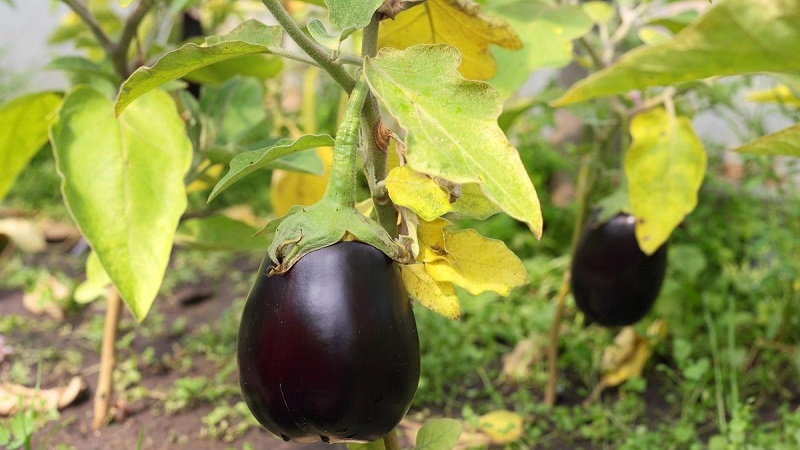
Why do the upper leaves turn yellow
The upper part of the plant turns yellow with a deficiency of manganese, iron and chlorine... If the eggplant receives less of these substances from the soil, its top dies off. In addition, this pathology can be a sign of decay of the root system due to an excess of moisture.
Why seedlings turn yellow
Seedling leaves can turn yellow regardless of whether the crop is growing on a windowsill or in a greenhouse. It could be caused by the following reasons:
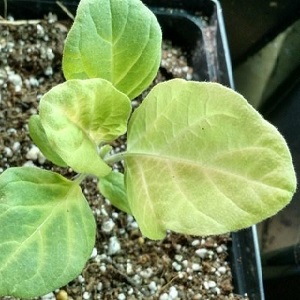 Lack of nutrition... If there are few micro- and macroelements in the soil, only the upper leaves are enough vital substances, and the cotyledon plates gradually dry out. In this case, it is necessary to increase the fertility of the soil with the help of a special seedling fertilizer, which is sold in a specialized store. Nitrogen is especially useful for young plants.
Lack of nutrition... If there are few micro- and macroelements in the soil, only the upper leaves are enough vital substances, and the cotyledon plates gradually dry out. In this case, it is necessary to increase the fertility of the soil with the help of a special seedling fertilizer, which is sold in a specialized store. Nitrogen is especially useful for young plants.- Infection of planting material... To be sure that the seeds are not affected by pathogens, they must be treated with a manganese solution before planting.
- Excess sunlight... If the seedlings are exposed to the scorching sun, their young leaves may dry out.
- Soil acidification... Eggplants need abundant watering, they do not tolerate drought. But if there is too much water and it stagnates, the roots will rot. If this process has already begun, giving up watering for a couple of days is not enough. Fungi or pathogens have already appeared in the ground, so it is replaced, and the pots are treated with potassium permanganate.
Why the fruits do not turn blue, but turn yellow
Most eggplant varieties turn purple or dark blue when ripe. Only some varieties of culture brought to us from North America or Asia have a light green or white-green hue. But if the color of the peel is unusual for the variety, this should alert summer resident.
Eggplants are capable of accumulating the toxic alkaloid solanine. This substance not only makes the fruit taste bitter, but also gives them a green, yellow or brown color. A common cause of eggplant discoloration is over-ripening.... But sometimes the culture turns yellow due to excess nitrogen or a lack of sunlight. In this case, its development slows down and the fruits brighten.
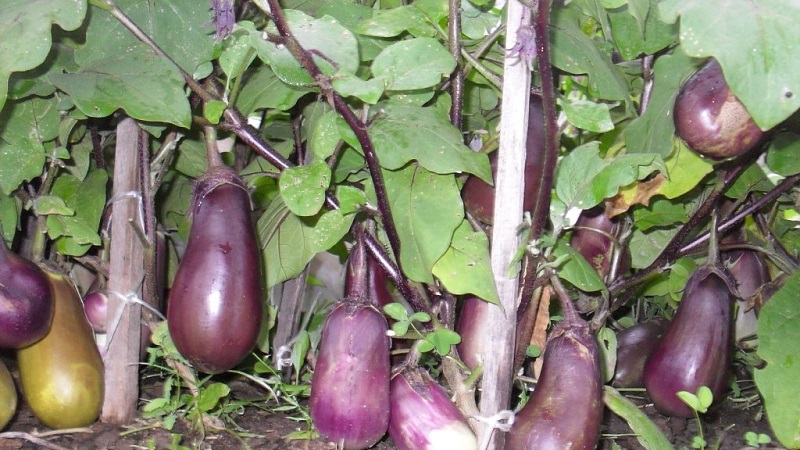
In dry weather, ripe eggplants may turn yellow or turn green... Water the plants regularly to avoid spoiling the crop.
What to do
If the plant is found spider mite, carry out treatment with such drugs as "Actellik", "Fitoverm" and others. From natural remedies, an infusion of finely chopped garlic or onion skins is suitable.
Potash fertilizers have antifungal effect... But if the fungus or viral infection has already penetrated the root system, the diseased plant can only be dug up and burned to avoid the spread of the disease. The soil is then disinfected with a solution of potassium permanganate. To save healthy specimens, they are treated with benzimidazole.
If burns appear on the sheet plates, move the seedlings to a shaded area and feed them until they recover.
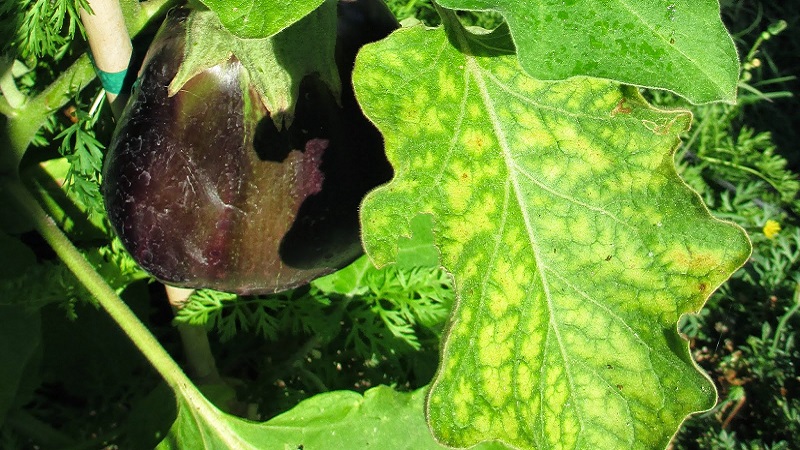
Preventive measures
To prevent damage and death of the culture, follow these recommendations:
- there should be holes in the seedling containers from which excess moisture will drain into the pallet;
- when watering, the liquid should not collect on the leaves;
- before planting, the seeds are washed with a non-concentrated solution of potassium permanganate, pots and garden tools are also disinfected;
- when transplanting a culture, its roots should not be exposed;
- the soil is regularly loosened so that air flows to the roots;
- do not plant eggplants in places where moisture often accumulates;
- damaged leaves are removed immediately.
Tips and tricks from experienced summer residents
For good acclimatization of seedlings, seeds are planted in a mixture of prepared soil and soil taken from the garden. But such soil can contain pests and pathogens. Disinfecting the soil in several ways:
 Steaming... The earth is placed in a colander and held over a pot of boiling water for about ten minutes, stirring occasionally. After that, the soil is cooled.
Steaming... The earth is placed in a colander and held over a pot of boiling water for about ten minutes, stirring occasionally. After that, the soil is cooled.- Etching... The soil is abundantly watered with a weak solution of potassium permanganate.
- Freezing... In the cold season, when the air temperature does not rise above -15 ° C, a container with pre-prepared soil is put outside for several days. Then they are brought into a warm room for five days to allow the larvae and seeds to wake up, and again taken out into the cold. This procedure is repeated three times.
- Calcination... The soil must be poured onto a metal tray with a layer about 5 cm thick and placed in an oven heated to + 70-90 ° C. It is important to ensure that the temperature does not rise above the set values. When the earth warms up, it is taken out of the oven and left to cool completely.
Seeds collected from healthy, fully ripe fruits are less prone to various diseases. The seed is thoroughly dried and put into storage in air-permeable bags.
Important! Do not plant eggplants near trees, buildings, fences, or near tall and lush crops that block the sun. Take care of the correct crop rotation. Do not plant seedlings in a garden bed where tomatoes, eggplants, or peppers grew last year.
Conclusion
Eggplants, like other crops, are susceptible to various diseases. Yellowing of leaves is caused by a number of reasons: pest infestation, fungal infections, inappropriate soil or micronutrient deficiencies. Inspect all parts of the plant regularly so that you can take action in time and prevent damage to the crop.